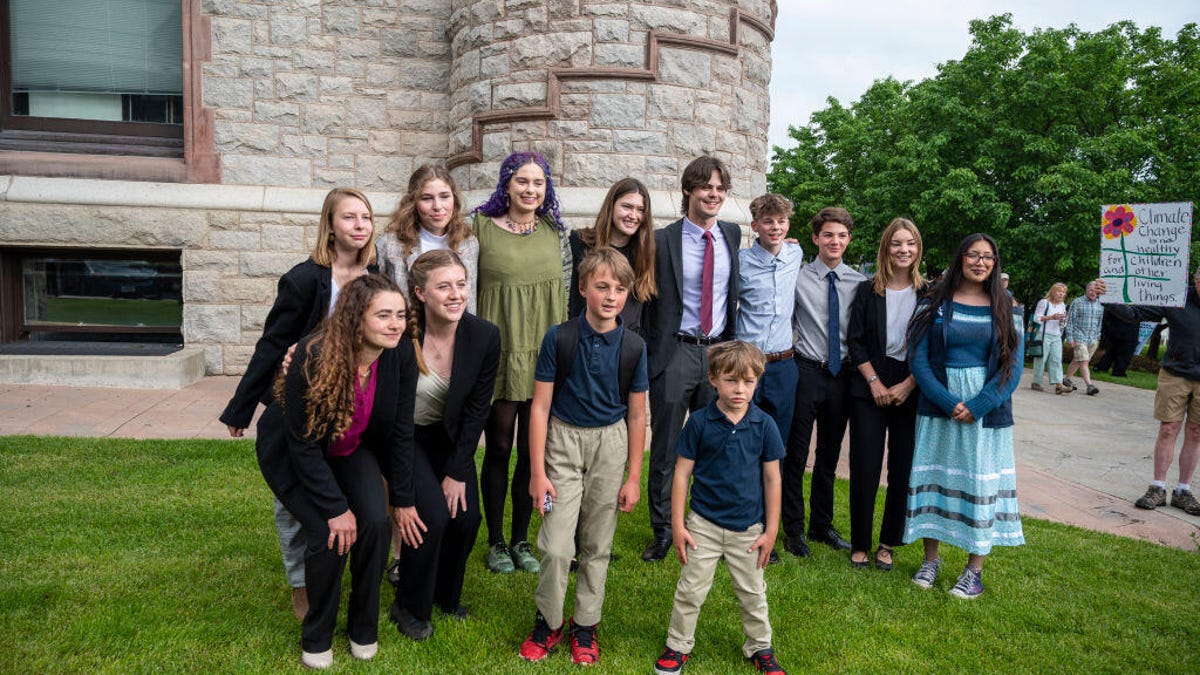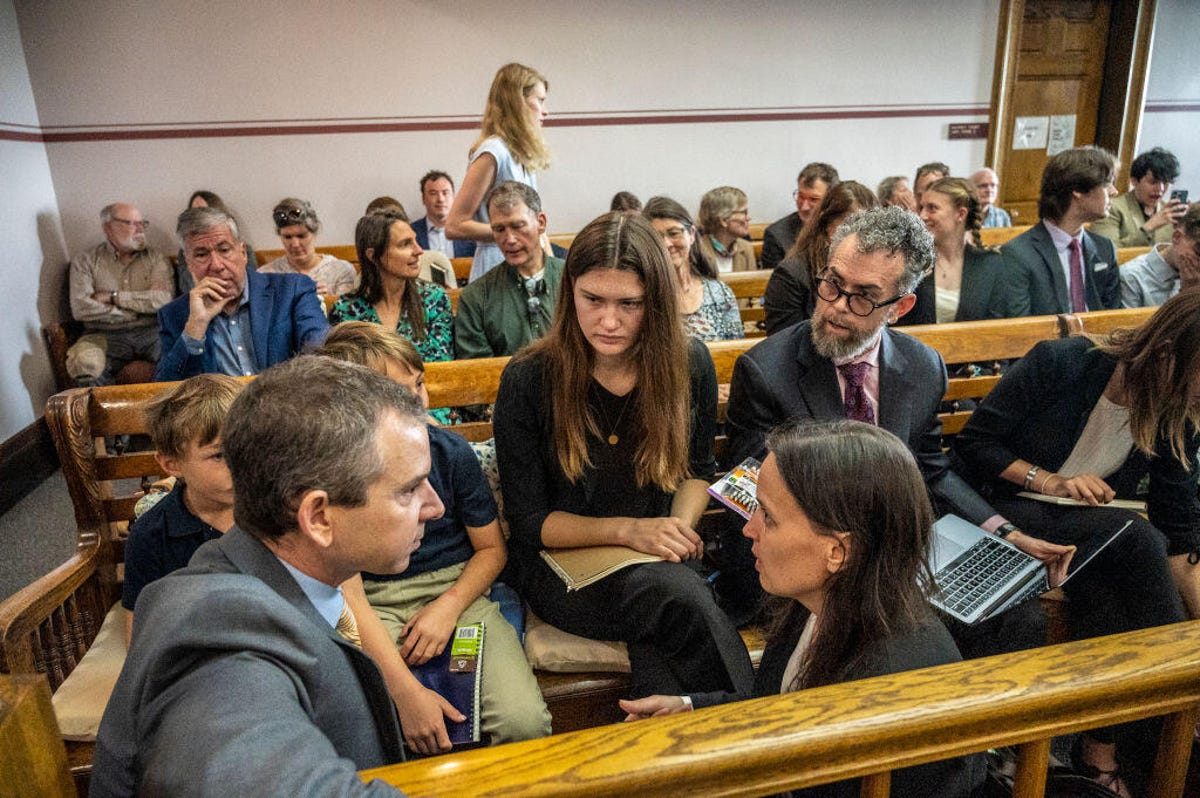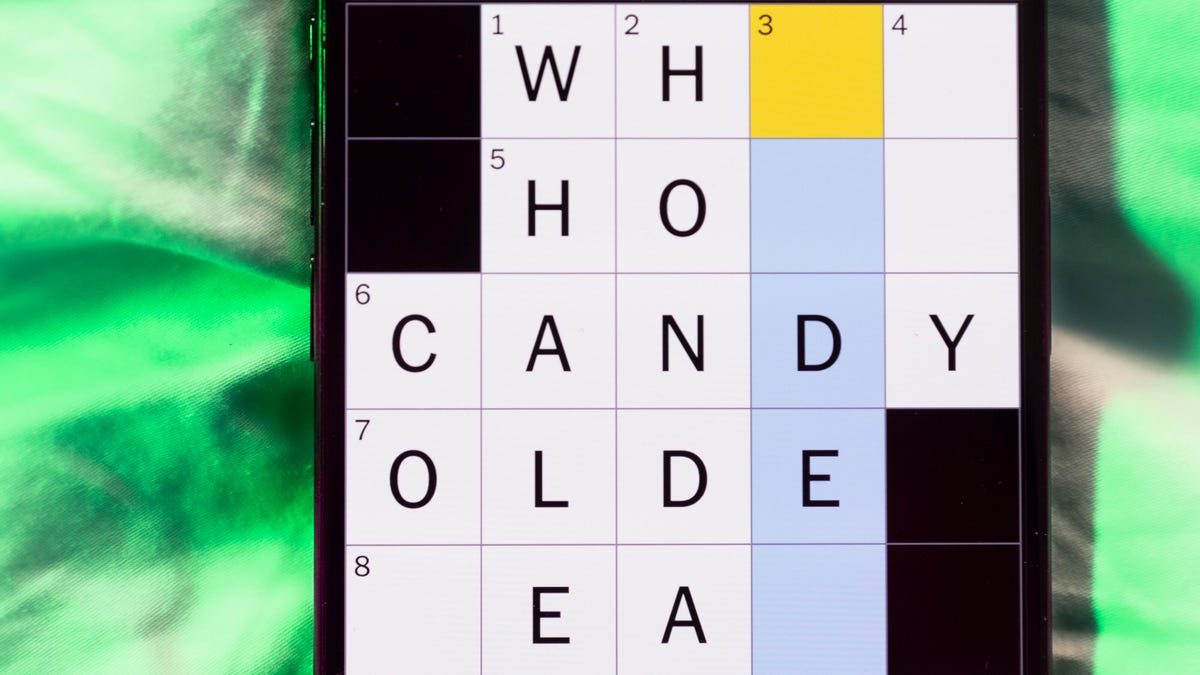Technologies
Gen Z Prevailed in a Climate Lawsuit. More Youth Trials Are on the Way
Young people fighting for a better future for the planet are beginning to discover that the law is on their side.

For two weeks in June, a Montana court heard from young people – 16 in total, ages 5 to 22 – and their families about the toll of extreme weather events caused by climate change on their health and other aspects of their lives.
They argued that the state of Montana had violated their constitutional rights to, among other things, a clean and healthful environment, by supporting a fossil fuel energy system and by failing to take action that would protect them against the harmful effects of climate change.
On Monday, after a two-month wait, they learned that they’d won.
In a landmark victory, Judge Kathy Seeley ruled in their favor, concluding in a 103-page decision that they’d proved significant injuries had occurred. Not only that, the decision in Held v. Montana said the case, launched in 2020, had shown that the Montana state government had been instrumental in causing these injuries and would be required to make changes to its conduct.
It’s a ruling that will likely have repercussions well beyond Montana’s state lines.
«We set the precedent not only for the United States, but for the world,» said 18-year-old Kian Tanner from Bigfork, Montana, in a statement.
It’s also another sign that Generation Z is finding new and forceful ways to make itself heard on climate issues. Gen Zers are using legal systems in the US and other countries to try to stem the damage being done by the burning of fossil fuels and the resulting greenhouse gases and to hold the responsible parties accountable.
Most young people are encouraged to avoid brushes with the legal system, but the plaintiffs in Montana, underpinned by legal team Our Children’s Trust, join a growing number of youth from around the world who are wielding the law to pressure governments into taking more radical action on climate.
Now that we’re regularly facing the impacts of human-caused climate change in our daily lives in the form of extreme weather events or breathing in smoke from forest fires, it’s easy to feel overwhelmed or powerless. But there are things we can do: recycle, cut down on car use, install solar panels and heat pumps, vote eco-friendly and support environmental campaigns. And litigate.
The Montana plaintiffs didn’t seek financial damages for the harms they’ve suffered due to climate change. Instead they wanted to change the current system – they sued over a law that prohibited the state from considering greenhouse gas emissions or climate change impacts when greenlighting fossil fuel projects.
«Young people are turning to court because they know that this isn’t about just the consumer choices that people make,» said Andrea Rodgers, senior litigation attorney at Our Children’s Trust, in an interview ahead of the verdict being issued. «This is about how we get energy, how we transfer goods, those kinds of systemic issues that governments really control.»
Monday’s decision is a game-changer, said Julia Olson, chief legal counsel and executive director with Our Children’s Trust, in a statement. «More rulings like this will certainly come.»
Here’s a look at some other prominent climate cases being driven by young people.
Kids vs. climate change
Way back in 2015, 21 young people filed a constitutional climate lawsuit against the federal government. They asserted that through government actions that cause climate change, it has violated the youngest generation’s constitutional rights to life, liberty and property.
Known as Juliana v. The United States, the federal case (also backed by Our Children’s Trust) was delayed by opposition from the Department of Justice under the Trump administration. Then, in June of this year, US District Court Judge Ann Aiken ruled that it can proceed to trial. Now the organizations supporting the young plaintiffs are asking the Biden administration not to delay the trial further.
«It’s long past time for the Department of Justice to end its opposition to the Juliana plaintiffs and youth climate justice,» said Zanagee Artis, founder and executive director of youth activist nonprofit Zero Hour. «Young Americans have the right to be heard by our nation’s courts, the branch of our government that has a duty to protect our constitutional right to a livable planet.»
For many years, courts were reluctant to hear and decide the merits of climate cases, said Rodgers. Just getting the Montana case to trial was a victory that signified «a real moment of change,» she added, that’s paved the way for trials to proceed both in the Juliana case and in another case that Our Children’s Trust is pursuing, in Hawaii.
Rodgers says the courts are now opening their doors to American youth because of the increasingly real and visceral impacts of climate change. «That does make a difference,» she said, «because it takes the injuries that the youth are experiencing … from being hypothetical to being real and tangible.»
Youth victories in and out of court
In the climate justice movement, young activists are key players in moving the needle on key issues, through protests, direct action and dialogues with politicians. But the combination of youth activism and legal action can be an especially potent mix.
In 2018, Indigenous climate activist and environmental engineer Yurshell Rodriguez, now 28, was one of 25 young people who successfully sued the government of Colombia for failing to reduce deforestation of the Amazon rainforest, thereby threatening their fundamental rights to a healthy environment, life, health, food and water. The lawsuit resulted in an intergenerational pact that meant the government had to consult with the plaintiffs, the affected communities and scientists to reduce deforestation in the Amazon.
«Activism sends a powerful message that the younger generation refuses to inherit a world plagued by environmental degradation and the consequences of inaction,» Rodriguez said in an interview. «But through lawsuits, we are raising awareness, mobilizing public support and challenging the status quo, compelling governments to prioritize sustainable policies, reduce carbon emissions and protect the planet for future generations.»

Young plaintiffs shouldn’t get discouraged if a judge rules against them, Rodriguez says – the awareness and public support a legal case can drive is also a positive result, which can in turn force the government’s hand.
In Europe in 2021, the People’s Climate Case, brought by 10 families including their children, was ultimately ruled inadmissible on a technicality by the Court of Justice of the European Union, but it spurred the EU to ramp up its fossil fuel reduction targets. «It’s all about kind of embarrassing the government into action,» said British human rights barrister Marc Willers.
There are always benefits to having young people tell their stories in open court alongside expert evidence and see states fail to defend their inaction, says Rodgers. «Even though there have been defeats and decisions that we consider to be unfavorable, it is still moving the ball forward.»
How to sue your government
No matter your age, it can be a «daunting prospect» to take on the state, even more so a fossil fuel giant that will throw everything it has at fighting your claim and attempting to discredit you, said Willers, who’s worked on a number of high-profile international environmental cases.
To bring a legal case, you’re going to need the support of sympathetic lawyers and an NGO or grassroots climate organization that knows the system and provides the necessary support, Willers said. He also advises forming a group, as the young people in the Montana and Juliana cases did, rather than going it alone, and finding a legal team that’s willing to spend time getting to understand your perspective.
In his work, Willers said, he’s found there are «real benefits to having young people involved in the litigation.» Children and youth can bring energy, positivity and unique viewpoints into the courtroom as representations of the future generations inheriting the Earth. They’re also often more knowledgeable about the issues than people give them credit for.

Young people often have a sophisticated understanding of the science combined with a sense of frustration and impatience, said Rodgers. She cited the example of a climate activist who achieved worldwide renown in her teens. «Greta Thunberg probably expresses that most prominently, but she’s simply expressing the feelings of youth universally, in my experience.»
Mounting global pressure
There’s no sign of youth-led climate litigation slowing down, what with legal wins in Colombia and Montana; the first lawsuit involving individuals versus the federal government underway in the US; and a major trial due to kick off in France this September based on six children and young adults suing 32 European countries.
As in the Montana case, the plaintiffs in that European case, all from Portugal, aren’t seeking financial damages – even though they’re entitled to. Instead, they’re pursuing a legally binding decision from the European Court of Human Rights that would require the countries to take action against climate change.
The more these cases occur around the world, the more they build momentum and make the voices of youth harder to ignore, said Rodgers. «What’s really cool is seeing these young people inspiring one another and building off of one another’s work.»
Such cases are strengthened by the fast-evolving field of attribution science, which can increasingly draw direct lines between specific emissions and the harms they’re causing. Lawsuits lodged by individuals against companies or institutions will only continue to get stronger and more frequent as our understanding of the science of climate change improves, Willers predicts.
When taking the legal route, progress can be painfully slow, as the young people in the now 8-year-old Juliana case have discovered. Some of them are no longer the kids they were at the time the suit was filed. But with children more aware than ever of growing up in a world threatened by climate change, there will be no shortage of young people willing to fight for their rights.
Rodriguez, who’s been there herself, is supportive of other young people considering demanding accountability and pushing for new measures through legal action. She encourages them to see themselves as «custodians of the future» who can leverage their voices and rights to hold those in power responsible for safeguarding the environment.
«To all the young people I will just say: Our actions inspire hope and serve as a reminder that collective efforts are essential in tackling the complex challenges of this climate crisis,» she says. «Be the change you want to see.»
Technologies
Today’s NYT Mini Crossword Answers for Saturday, Dec. 27
Here are the answers for The New York Times Mini Crossword for Dec. 27.

Looking for the most recent Mini Crossword answer? Click here for today’s Mini Crossword hints, as well as our daily answers and hints for The New York Times Wordle, Strands, Connections and Connections: Sports Edition puzzles.
Need some help with today’s Mini Crossword? It’s pretty long for a Mini Crossword, and some of the clues are tricky. The answer to 10-Across is not an expression I use, for sure. Read on. And if you could use some hints and guidance for daily solving, check out our Mini Crossword tips.
If you’re looking for today’s Wordle, Connections, Connections: Sports Edition and Strands answers, you can visit CNET’s NYT puzzle hints page.
Read more: Tips and Tricks for Solving The New York Times Mini Crossword
Let’s get to those Mini Crossword clues and answers.
Mini across clues and answers
1A clue: Fashionable
Answer: HIP
4A clue: Product sold on «The Office»
Answer: PAPER
6A clue: One writing a performance review
Answer: MANAGER
8A clue: With 5-Down, redundant synonym of «outcome»
Answer: END
9A clue: Quiet ___ mouse
Answer: ASA
10A clue: Gives constant compliments, in slang
Answer: GASESUP
12A clue: Ski mountain bump
Answer: MOGUL
13A clue: Uneasy feeling
Answer: ANGST
Mini down clues and answers
1D clue: Personally involved
Answer: HANDSON
2D clue: Hoppy beer, for short
Answer: IPA
3D clue: Mythical horse whose name is an anagram of 10-Across
Answer: PEGASUS
4D clue: Last word in the palindromic sentence «A man, a plan, a canal …»
Answer: PANAMA
5D clue: See 8-Across
Answer: RESULT
6D clue: Ryan of «When Harry Met Sally …»
Answer: MEG
7D clue: Genre for Playboi Carti and Cardi B
Answer: RAP
11D clue: Something in an Easter basket
Answer: EGG
Don’t miss any of our unbiased tech content and lab-based reviews. Add CNET as a preferred Google source.
Technologies
Today’s NYT Connections: Sports Edition Hints and Answers for Dec. 27, #460
Here are hints and the answers for the NYT Connections: Sports Edition puzzle for Dec. 27, No. 460.

Looking for the most recent regular Connections answers? Click here for today’s Connections hints, as well as our daily answers and hints for The New York Times Mini Crossword, Wordle and Strands puzzles.
Today’s Connections: Sports Edition is a real challenge. That purple category wants you to hunt out something related in four different words, and it’s a toughie. If you’re struggling with today’s puzzle but still want to solve it, read on for hints and the answers.
Connections: Sports Edition is published by The Athletic, the subscription-based sports journalism site owned by The Times. It doesn’t appear in the NYT Games app, but it does in The Athletic’s own app. Or you can play it for free online.
Read more: NYT Connections: Sports Edition Puzzle Comes Out of Beta
Hints for today’s Connections: Sports Edition groups
Here are four hints for the groupings in today’s Connections: Sports Edition puzzle, ranked from the easiest yellow group to the tough (and sometimes bizarre) purple group.
Yellow group hint: Something you save.
Green group hint: An Olympic sport.
Blue group hint: Toronto pitchers.
Purple group hint: Think about the alphabet and look for something hidden.
Answers for today’s Connections: Sports Edition groups
Yellow group: Memento.
Green group: Types of wrestling.
Blue group: Blue Jays to win Cy Young Award.
Purple group: Ends in a homophone for a letter of the alphabet.
Read more: Wordle Cheat Sheet: Here Are the Most Popular Letters Used in English Words
What are today’s Connections: Sports Edition answers?
The yellow words in today’s Connections
The theme is memento. The four answers are collectible, keepsake, memorabilia and souvenir.
The green words in today’s Connections
The theme is types of wrestling. The four answers are arm, freestyle, Greco-Roman and sumo.
The blue words in today’s Connections
The theme is Blue Jays to win Cy Young Award. The four answers are Clemens, Halladay, Hentgen and Ray.
The purple words in today’s Connections
The theme is ends in a homophone for a letter of the alphabet. The four answers are batter’s eye (I), blue jay (J), golf tee (T) and pool cue (Q).
Don’t miss any of our unbiased tech content and lab-based reviews. Add CNET as a preferred Google source.
Technologies
Today’s Wordle Hints, Answer and Help for Dec. 27, #1,652
Here are hints and the answer for today’s Wordle for Dec. 27, No. 1,652.

Looking for the most recent Wordle answer? Click here for today’s Wordle hints, as well as our daily answers and hints for The New York Times Mini Crossword, Connections, Connections: Sports Edition and Strands puzzles.
Today’s Wordle puzzle came together pretty quickly for me this time. If you need a new starter word, check out our list of which letters show up the most in English words. If you need hints and the answer, read on.
Read more: New Study Reveals Wordle’s Top 10 Toughest Words of 2025
Today’s Wordle hints
Before we show you today’s Wordle answer, we’ll give you some hints. If you don’t want a spoiler, look away now.
Wordle hint No. 1: Repeats
Today’s Wordle answer has no repeated letters.
Wordle hint No. 2: Vowels
Today’s Wordle answer has one vowel.
Wordle hint No. 3: First letter
Today’s Wordle answer begins with B.
Wordle hint No. 4: Last letter
Today’s Wordle answer ends with H.
Wordle hint No. 5: Meaning
Today’s Wordle answer can refer to a quantity of goods produced at one time.
TODAY’S WORDLE ANSWER
Today’s Wordle answer is BATCH.
Yesterday’s Wordle answer
Yesterday’s Wordle answer, Dec. 26, No. 1651 was SPEED.
Recent Wordle answers
Dec. 22, No. 1647: CONCH
Dec. 23, No. 1648: GLINT
Dec. 24, No. 1649: SPOOL
Dec. 25, No. 1650: PRISM
Don’t miss any of our unbiased tech content and lab-based reviews. Add CNET as a preferred Google source.
-

 Technologies3 года ago
Technologies3 года agoTech Companies Need to Be Held Accountable for Security, Experts Say
-

 Technologies3 года ago
Technologies3 года agoBest Handheld Game Console in 2023
-

 Technologies3 года ago
Technologies3 года agoTighten Up Your VR Game With the Best Head Straps for Quest 2
-

 Technologies4 года ago
Technologies4 года agoBlack Friday 2021: The best deals on TVs, headphones, kitchenware, and more
-

 Technologies4 года ago
Technologies4 года agoVerum, Wickr and Threema: next generation secured messengers
-

 Technologies4 года ago
Technologies4 года agoGoogle to require vaccinations as Silicon Valley rethinks return-to-office policies
-

 Technologies4 года ago
Technologies4 года agoOlivia Harlan Dekker for Verum Messenger
-

 Technologies4 года ago
Technologies4 года agoiPhone 13 event: How to watch Apple’s big announcement tomorrow
